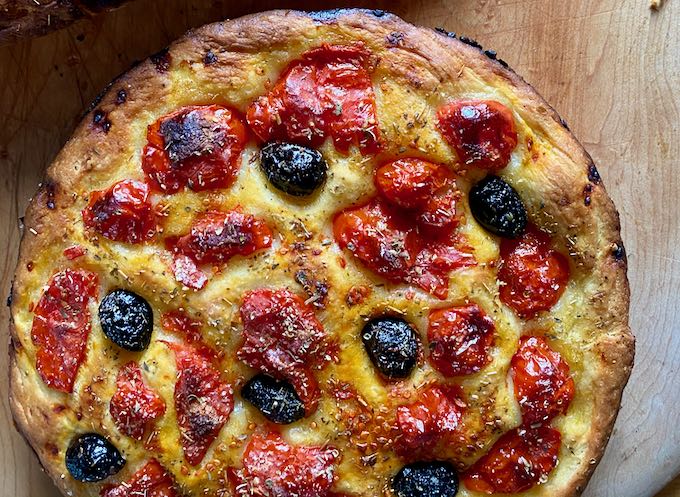
A few weeks ago (or was it a few years ago? who’s to know?) Sophie made the most delicious focaccia barese and documented it on Instagram. Since I realize that a) everyone in the world is making focaccia these days and that b) not everyone can figure out how to follow the video I linked to last week, I thought it would be helpful to print out the recipe here.
The reason we decided to make this was because we were missing Puglia. This particular recipe is one that you’ve seen us eating every time we go to Bari. What makes this focaccia different from focacia in other regions of Italy is both the way it is baked and the ingredients.
Flour: one of the flours that is used is semolina. This gives the focaccia it’s particular yellowish hue as well as the distinctive chewiness
Olive Oil: there is a lot of olive oil going on. In the dough, on the top and in the pan. This makes the focaccia unctious and rich, as well as crunchy on the edges and bottom.
Baking: in Bari they bake it in much used heavy metal pans in very hot ovens. This makes the bottom really crisp, almost fried. We found the best at home substitute was a cast iron pan.
Tomatoes: the most intense cherry tomatoes you can find get scattered on the top.
Sophie followed this Barese lady who she LOVES. But I can understand if you can’t follow along, so I’ve written the recipe below.
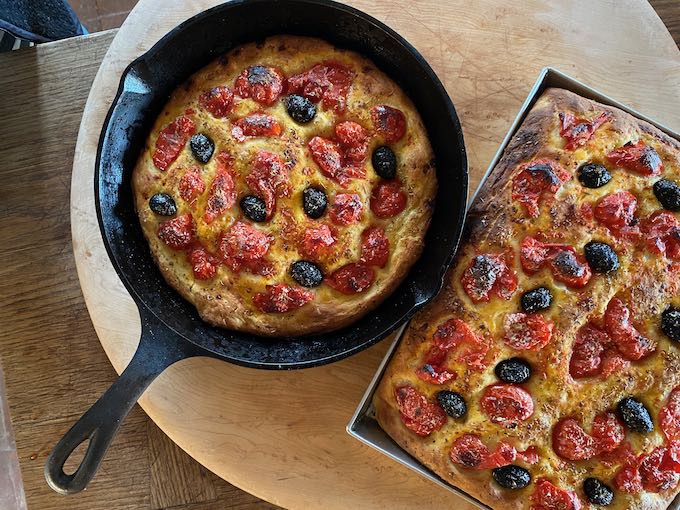
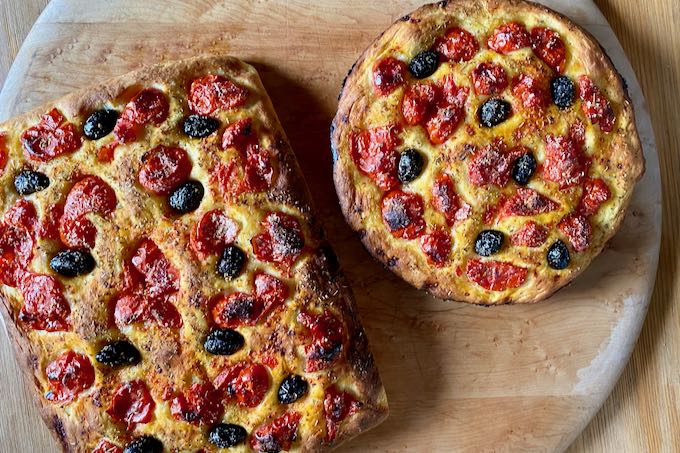
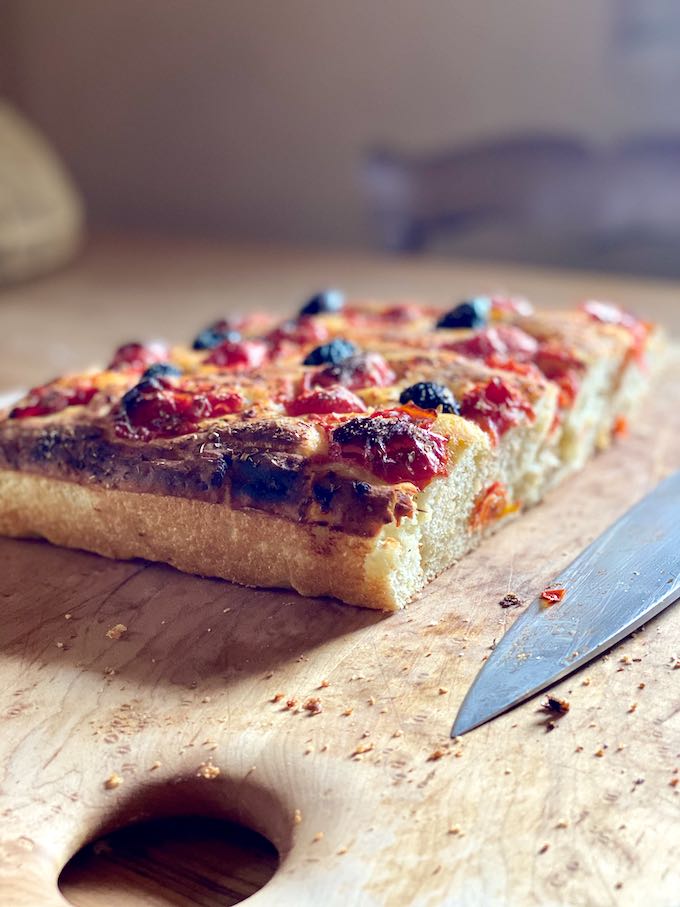
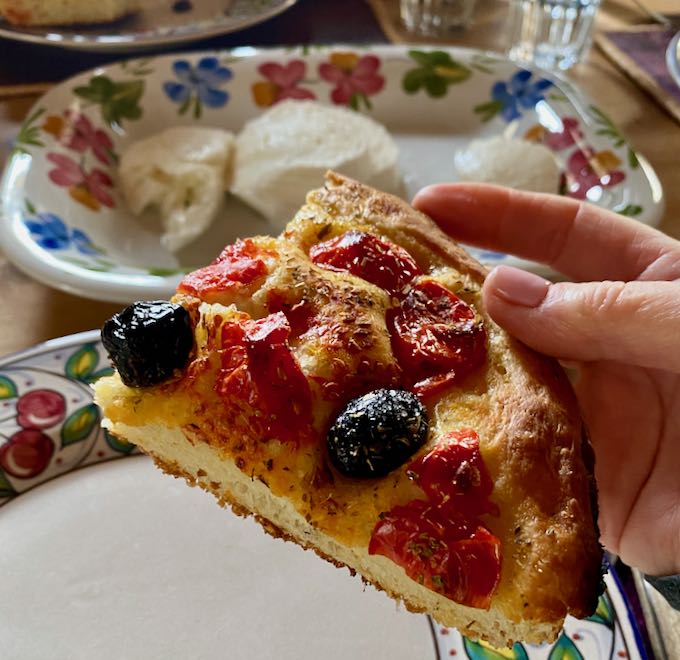
Focaccia Barese
Ingredients
- 12 gr fresh yeast (2 tsp active dry yeast)
- 350 gr/ 2 3/4 cups all purpose flour
- 340ml / 1 1/2 cups room temperature water
- 250 gr / 2 cups Grano Duro rimacinato (semolina flour)
- 5 gr / 1/2 tsp sugar
- 1 medium potato, boiled, cooled and mashed
- 10 gr / 1 tsp salt
- 25 gr / 3 tblsp extra virgin olive oil plus more for top
- 10 cherry tomatoes
- 1/2 cup black or green olives
- oregano
- course salt
Instructions
- In a large bowl dissolve the yeast in half the water. Add the potato and mix in into the water. Then add the remaining water, olive oil, sugar and salt. Mix well.
- Add all the flour and mix with your hands until smooth and elastic. When it comes together, transfer it to the counter and continue kneading, for about 8 minutes
- Shape the dough into a ball, and place into a lightly oiled bowl. Cover with a cloth and let rise for about 3 hours.
- Coat 2 pans liberally with olive oil. We found that using a cast iron pan worked best. Divide the dough in two, and, using your hands, stretch it out to cover the pans. You may have to let it rest for a few minutes, to relax.
- Cover the pans and let rise for another 30 minutes.
- Preheat the oven to 250/300C (500/600F).
- Before putting the focaccia in the oven, brush the dough with olive oil. Add the tomatoes, crushing them with your hands so that the juices flow onto the dough. Scatter the olives as well, and using your fingers kind of push the tomatoes and the olives into the dough a bit. Season with salt and oregano and bake for 15-20 minutes.If your oven isn’t hot enough, it might take longer.
For more inspiration and recipes see my book The Italian Table.
And if you’d like to join us in Puglia to eat some Focaccia Barese in Bari then join us on our Week in Puglia Tour.
You forgot to list the water in your recipe ingredient list. From the Italian recipe, it appears to be 340-390ml, or 11.5-13oz.
Thanks! Putting it there now!
Also, I can say now that having made this, it tastes as good as it looks. Thanks for the recipe idea!
Hi Elizabeth,
Love following you by email and on Instagram!
I wanted to let you know that this recipe does not have the water listed on it. I found the amount in your Instagram stories, but in case you wanted to add that in there!
Thanks for sharing the recipe! I also tried to follow the video but my Italian is virtually non-existent!
Adding now!
Hi Elizabeth! Thank you so much for the focaccia recipe. What size pans are you recommending?
And also… I thought if you mixed salt with yeast in the beginning… It slows the yeast down. But I also noticed that this is not an especially thick focaccia so maybe The early edition of salt is not an issue here. Thanks so much.
Don’t know, but this recipe definitely works!
I think it was sugar added at the beginning and not salt. The salt was added later on.
This is an excellent recipe. My daughter in Paris, and me, in Tacoma, Washington, USA, just made this together virtually via Face Time. We checked in four times from beginning until the tasting of the final product. Cast iron (skillet, dutch oven) is recommended. Mine cooked in cast iron, my daughter in a porcelain baking pan. Mine cooked more quickly.
A second suggestion is that thinner is better. My pans are two different diameters. The focaccia from the larger one is crisper.
I think one could put artichoke hearts, sun dried tomatoes, etc. on this too. The recipe seems quite versatile.
Totally agree, the thinner the better and cast iron for the win!
Going to make this for the second time today, as the leftovers were wonderful the last time I baked. And it’ll be such a good treat for Easter tomorrow. But wanted to thank you for adding the print option this time .. AND the measuring conversion from gr to cups for us Americans. (Now I don’t have to guess w google.) Grazie mille e Buona pasqua!
Hi, I am the videomaker from Bari of the Focaccia Barese, video you linked 😉 wow great result. Your focaccia looks like the authentic one. Thanks for sharing!
Wow!!! Thank you for commenting!! We love your site, and my daughter Sophie is a huge fan! I’ll add the link to your website to this post.
Hello – this looks amazing. If I half the recipe, does the dough need to rise for the same amount of time?
Thanks!
Yes.
Can I freeze half after it rises for three hours?
I’m not sure! I usually bake it, then freeze it.
Hello, can you use instant yeast instead? If so, do you only use half the water? Thank you!
Sorry, but I’m not a yeast expert. There are plenty of websites though, for figuring out yeast equivalents.
I used instant yeast and didn’t change anything else.
Hi! Is it just me but 2 cups of semolina doesn’t make 250g?? It takes one cup of semolina to have 250g… Anyway, this is soooooooooo good!
It’s hard converting cups to grams, and that is why most bakers use grams…..
THIS IS DELICIOUS!! first saw it on Sophie’s Instagram. Mine came out fantastic. I did one traditionally with tomatoes and olives. One with potatoes and a little green garlic from the market. Just a teeny note: the recipe calls for 10 cherry tomatoes and 1/2 cup olives…and that’s enough for just one cast- iron pan-full. The recipe makes two.
Cheers! and thanks for the inspiration. Super yummy.
So glad it turned out well! Actually, the amounts are correct. In Puglia the tomatoes and olives are more for seasoning, and not a real topping.
thank you for this! i always have trouble with the rising, and now i’ll try the dissolved yeast….makes perfect sense.
Yes, you should always dissolve the yeast. Hope it works out!
Hello! I just returned from a 2-week vacation with friends in Puglia, and this is one of the many delicious Pugliese dishes that I would like to make. I was just wondering — your photos show one round and one rectangular focaccias. May I know the sizes of the two, in inches? I would like to make 2 rectangular focaccias — should I use a 9-inch x 13-inches baking pan? Would there be enough dough to make the 2 rectangular ones? Thanks so much!
Regina Newport
I would double the recipe if you want to make 2 rectangular ones
I would just double the recipe to make 2 rectangular ones.